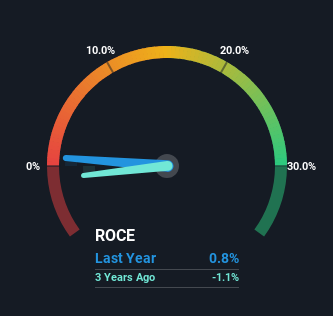What trends should we look for it we want to identify stocks that can multiply in value over the long term? One common approach is to try and find a company with returns on capital employed (ROCE) that are increasing, in conjunction with a growing amount of capital employed. Put simply, these types of businesses are compounding machines, meaning they are continually reinvesting their earnings at ever-higher rates of return. With that in mind, we've noticed some promising trends at Max India (NSE:MAXIND) so let's look a bit deeper.
Understanding Return On Capital Employed (ROCE)
For those that aren't sure what ROCE is, it measures the amount of pre-tax profits a company can generate from the capital employed in its business. Analysts use this formula to calculate it for Max India:
Return on Capital Employed = Earnings Before Interest and Tax (EBIT) ÷ (Total Assets - Current Liabilities)
0.0076 = ₹45m ÷ (₹7.5b - ₹1.6b) (Based on the trailing twelve months to March 2023).
Therefore, Max India has an ROCE of 0.8%. In absolute terms, that's a low return and it also under-performs the Healthcare industry average of 14%.
View our latest analysis for Max India

While the past is not representative of the future, it can be helpful to know how a company has performed historically, which is why we have this chart above. If you're interested in investigating Max India's past further, check out this free graph of past earnings, revenue and cash flow.
How Are Returns Trending?
Like most people, we're pleased that Max India is now generating some pretax earnings. The company was generating losses five years ago, but now it's turned around, earning 0.8% which is no doubt a relief for some early shareholders. In regards to capital employed, Max India is using 64% less capital than it was five years ago, which on the surface, can indicate that the business has become more efficient at generating these returns. Max India could be selling under-performing assets since the ROCE is improving.
The Bottom Line
From what we've seen above, Max India has managed to increase it's returns on capital all the while reducing it's capital base. Since the stock has returned a staggering 139% to shareholders over the last year, it looks like investors are recognizing these changes. With that being said, we still think the promising fundamentals mean the company deserves some further due diligence.
One more thing, we've spotted 2 warning signs facing Max India that you might find interesting.
If you want to search for solid companies with great earnings, check out this free list of companies with good balance sheets and impressive returns on equity.
New: Manage All Your Stock Portfolios in One Place
We've created the ultimate portfolio companion for stock investors, and it's free.
• Connect an unlimited number of Portfolios and see your total in one currency
• Be alerted to new Warning Signs or Risks via email or mobile
• Track the Fair Value of your stocks
Have feedback on this article? Concerned about the content? Get in touch with us directly. Alternatively, email editorial-team (at) simplywallst.com.
This article by Simply Wall St is general in nature. We provide commentary based on historical data and analyst forecasts only using an unbiased methodology and our articles are not intended to be financial advice. It does not constitute a recommendation to buy or sell any stock, and does not take account of your objectives, or your financial situation. We aim to bring you long-term focused analysis driven by fundamental data. Note that our analysis may not factor in the latest price-sensitive company announcements or qualitative material. Simply Wall St has no position in any stocks mentioned.
About NSEI:MAXIND
Max India
Provides services related to senior living communities in India.
Excellent balance sheet with very low risk.
Market Insights
Community Narratives



